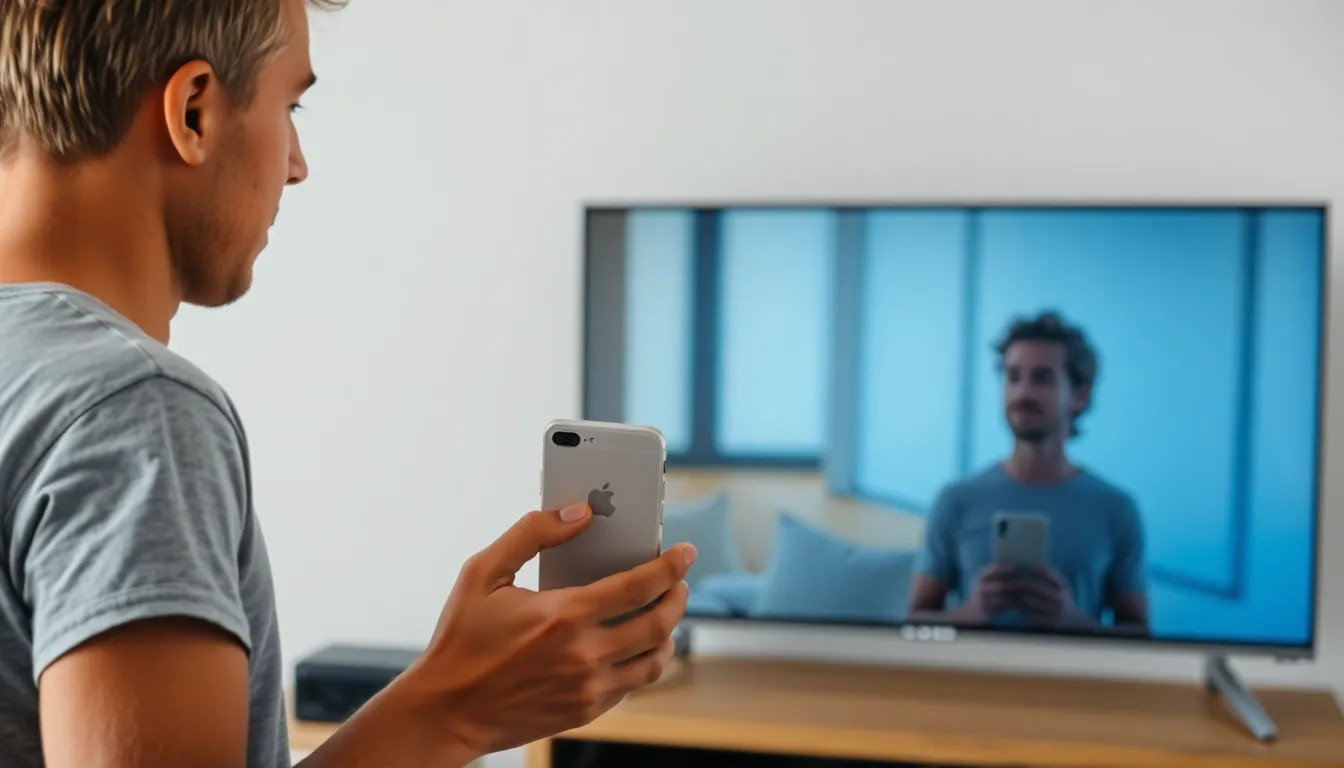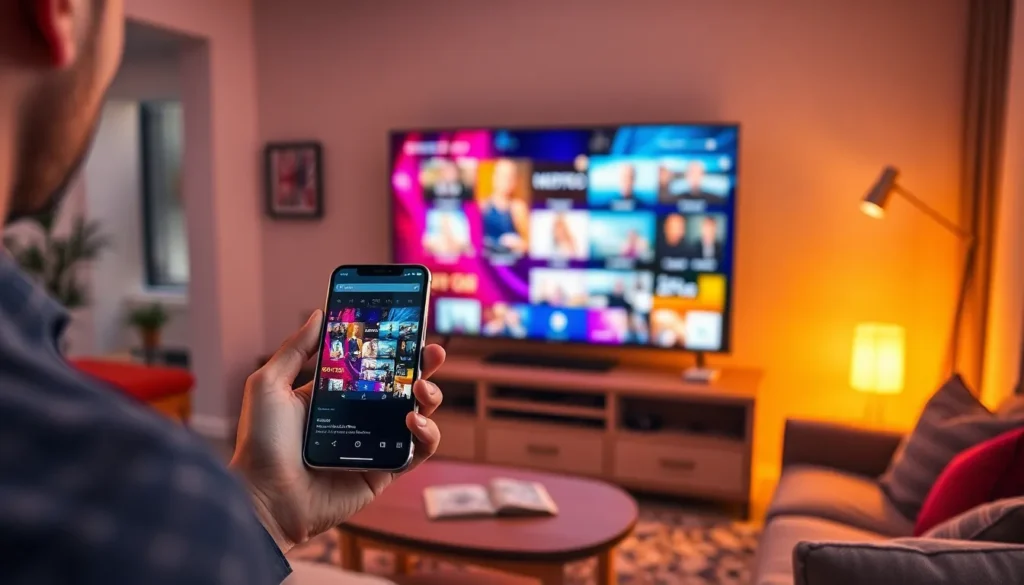Table of Contents
TogglePicture this: you’ve got a cozy night planned with your favorite movie, but instead of squinting at your iPhone screen, wouldn’t it be nice to share that cinematic experience on a big, glorious smart TV? Connecting your iPhone to a smart TV might sound like a techy puzzle, but it’s easier than finding the perfect avocado at the grocery store.
Overview of Connecting iPhone to Smart TV
Connecting an iPhone to a smart TV enhances viewing experiences by providing a larger screen for multimedia content. This process is straightforward, making it accessible for all users.
Importance of Connectivity
Connectivity plays a crucial role in modern entertainment. Wireless connections facilitate seamless streaming of content from iPhones to smart TVs. Establishing a connection allows users to enjoy their favorite shows, movies, and games on larger displays. High-definition quality attracts viewers seeking immersive experiences. Easy access to streaming apps ensures convenience and efficiency. Overall, solid connectivity transforms a standard viewing experience into a memorable event.
Benefits of Screen Sharing
Screen sharing expands the usability of an iPhone significantly. Users display photos and videos effortlessly on big screens, ideal for sharing memories during gatherings. Collaborating on presentations becomes easier when utilizing a smart TV as a shared display. Interactive gaming gains added excitement when players can engage on a larger surface. Screen sharing also enhances productivity by allowing users to multitask with comfort. Utilizing this feature transforms the way individuals interact with media and each other.
Methods to Connect iPhone to Smart TV

Connecting an iPhone to a smart TV offers several methods, each with unique advantages. These options cater to various preferences and equipment setups.
Using AirPlay
AirPlay simplifies the connection process for Apple device users. This wireless method allows streaming of videos, music, and photos to compatible smart TVs. Users must ensure their iPhone and TV connect to the same Wi-Fi network. To start, swipe down from the top right corner of the iPhone screen. Then, select “Screen Mirroring,” and choose the TV from the list. This option provides high-definition display quality, making media experiences more immersive.
Using HDMI Cable
For a direct and stable connection, an HDMI cable works effectively. An adapter, such as the Lightning Digital AV Adapter, connects the iPhone to the HDMI cable. Users should plug one end of the HDMI cable into the TV and the other end into the adapter. After switching the TV’s input to HDMI, it’s time to view the iPhone screen on the TV. This method guarantees a reliable connection, avoiding issues related to Wi-Fi interference.
Using Third-Party Apps
Several third-party apps facilitate iPhone and smart TV connectivity. Apps like AllCast or AirScreen provide additional features for users without built-in AirPlay support. Users can download these apps from the App Store or the TV’s app marketplace. After installation, open the app on the TV and the iPhone. Follow the on-screen prompts to connect the devices. Often, this method enhances functionality and allows for streaming a broader range of content.
Troubleshooting Common Issues
Connecting an iPhone to a smart TV may encounter some common issues. Identifying the problems quickly can simplify the troubleshooting process.
Connection Problems
A common issue arises when the iPhone fails to connect to the smart TV. Users should ensure both devices are on the same Wi-Fi network for seamless AirPlay functionality. Checking for software updates on both the iPhone and the smart TV can resolve compatibility problems. Restarting the router sometimes clears network-related issues as well. Any settings preventing connections should receive attention, such as firewalls or privacy settings.
Audio and Video Sync Issues
Audio and video sync issues can distract from the viewing experience. Delayed audio often occurs with wireless streaming; thus, users can try switching to a wired HDMI connection for improved synchronization. Adjusting settings on the smart TV or iPhone can sometimes mitigate the problem. Ensuring both devices have the latest software may also enhance performance. If the problem persists, restarting both devices generally improves the likelihood of restoring correct sync.
Tips for Optimal Experience
Maximizing the experience when connecting an iPhone to a smart TV requires attention to key factors. Users should consider several elements for the best performance.
Ensuring Compatibility
Check if the smart TV supports AirPlay or has HDMI inputs. Many recent models feature built-in AirPlay, enabling straightforward wireless streaming. Smartphones must also run on sufficient iOS versions to ensure smooth connectivity. Specific requirements may vary, so verifying compatibility with both devices beforehand saves time and frustration.
Improving Wi-Fi Performance
Location of the router impacts connectivity quality. Placing the router in a central location minimizes barriers that can disrupt the signal. Moreover, ensuring your smart TV and iPhone are on the same network emphasizes fewer connection issues. Ignoring congestion from multiple connected devices also helps maintain a strong signal. Users can enhance network performance by upgrading their router to one that supports the latest Wi-Fi standards, providing a more reliable streaming experience.
Connecting an iPhone to a smart TV opens up a world of entertainment possibilities. With methods like AirPlay or HDMI connections users can easily enjoy their favorite content on a larger screen. This enhances not only viewing pleasure but also the way people interact with media.
By following the tips for optimal performance and troubleshooting common issues users can ensure a smooth streaming experience. Embracing these technologies allows for seamless sharing of photos videos and games. Ultimately this connection transforms movie nights and gatherings into memorable experiences.







